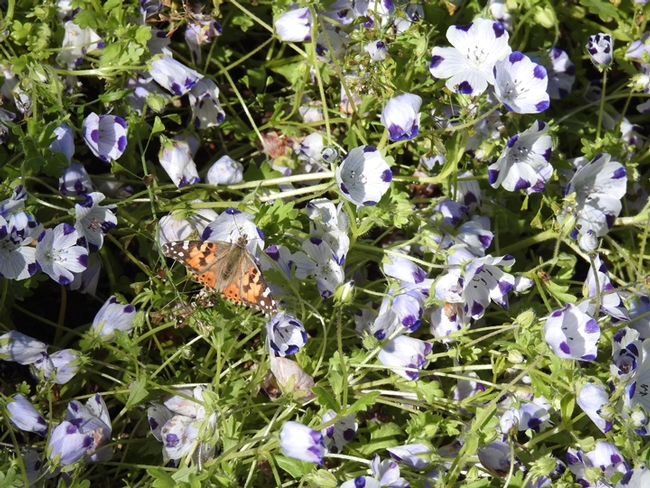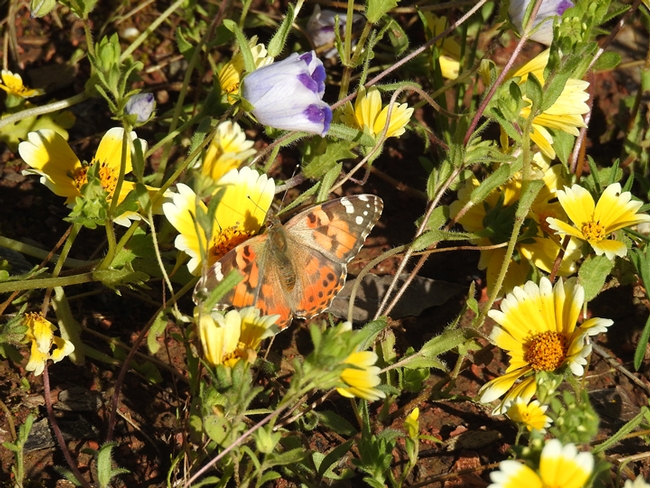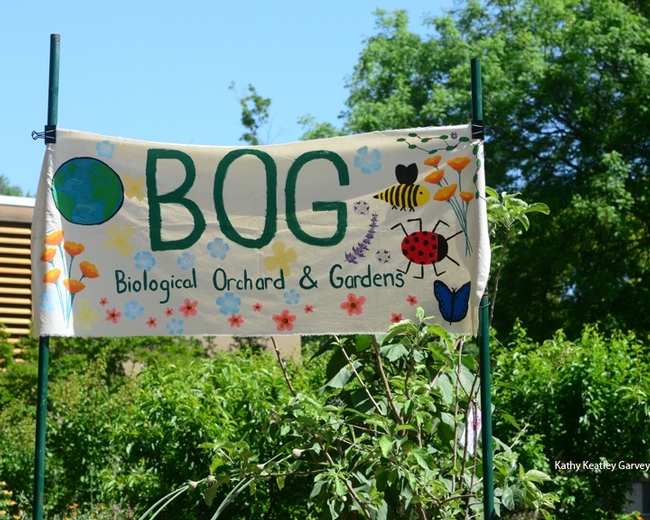In between the rains today, we saw them.
So beautiful! Painted ladies, Vanessa cardui, nectaring in patches of colorful wildflowers in the Biological Orchard and Gardens (BOG), located behind the Mann Laboratory on University of California, Davis campus.
The migratory butterflies, passing through California on their way to the Pacific Northwest, stopped there for some flight fuel: sipping nectar from tidy tips, Layia platyglossa; five-spot, Nemophila maculate, and blue lupine, Lupinus.
They've been in the national news a lot, these butterflies, as has butterfly guru Art Shapiro, UC Davis distinguished professor of evolution and ecology. Known for his expertise on all things butterfly, he's monitored the butterfly population of Central California since 1972 and maintains a research website.
Yes, it's been a big year for painted ladies, thanks to the heavy rainfall and super blooms in the deserts near the Mexican border. And, as Shapiro says, tremendous wildflower blooms are typically great years for the painted ladies.
New York Times reporter Julia Jacobs interviewed Shapiro for her March 17th piece, in which she marveled that millions of the painted ladies are migrating. Shapiro told her: "The striking thing is they're moving very rapidly and directionallly. So it's almost like being in a hail of bullets.”
Rita LeRoy or "Farmer Rita," the self-described "Farm Keeper" on the Loma Vista Farm, Vallejo, part of the Vallejo City Unified School District, saw the butterflies passing through the farm on Monday, March 17. Her description is fabulous:
"They came through Vallejo on Monday," she said. "Art's description was right on. It was like being in a hail of bullets. This was because they were flying so low and it was a constant stream, like standing in the middle of a 500 lane expressway. I kept telling the students, 'Look! Another, another, another...' The path was at least as wide as the farm which is about 200 yards. When I stood in one spot, I would agree they were passing within my vision (about 100') at about 1 every second. They rarely stopped to nectar but were flying in a very direct NE direction when they came through the farm. They flew through nonstop from before 1 p.m. and the flow started to dwindle around 4 p.m. Still enough at that point to show the after school kids. They didn't fly in huddled groups or clouds and they moved fast. I tried taking a video but it was like a bad remake of The Blair Witch Project, with unfocused, whiplash camera moves of uncertain objects since they are so small in the overall background. I'm so glad Art saw them."
Today (Wednesday) we didn't see the hail of bullets, but we did see about a dozen of them grabbing some flight fuel on the UC Davis campus over a 10-minute period.
If you get a chance, check out the Biological Orchard and Gardens. A 24,000-square-foot garden, located behind the Mann lab, off Kleiber Hall Drive, it's planted with several dozen species of heritage fruit trees, and landscaped with flower gardens. The painted ladies are elsewhere on campus, too, including the UC Davis Arboretum and Public Garden.
Attached Images:

A painted lady, Vanessa cardui, nectars on five-spot, Nemophilia maculate, Wednesday afternoon, in the Biological Orchard and Gardens (BOG), UC Davis campus. (Photo by Kathy Keatley Garvey)

Tidy tips, Layia platyglossa, in the UC Davis Biological Orchard and Gardens (BOG) drew painted ladies, Vanessa cardui, on Wednesday afternoon. (Photo by Kathy Keatley Garvey)

A sign welcomes visitors to the UC Davis Biological Orchard and Gardens (BOG). It is located behind Lot 26, behind the Mann Laboratory, off Kleiber Hall Drive. (Photo by Kathy Keatley Garvey)